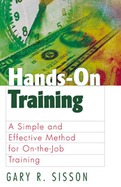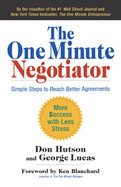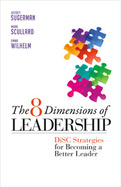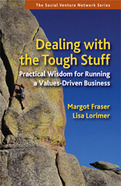2001
The first book to detail a systematic, practical, and easily applicable approach to On-the-Job Training (OJT)
Outlines a simple 6-step process that those performing OJT can easily follow to train workers to do their jobs
Presents a proven approach to training workers on job skills that is truly low cost and high return-and does not require extensive documentation or long development times
On-the-Job Training (OJT) is the single most used training method in organizations today. But it is also the most misused-because very few of those doing OJT are ever trained how to do it. In Hands-On Training Gary Sisson draws on his thirty-five years of experience to lay out a simple, systematic approach to OJT that can be understood and applied by anyone in any organization-- managers, line or staff supervisors, employees and both internal and external human resource and training professionals. Using the acronym "HOT POPPER" to help readers remember the parts of the process, Hands-On Training (HOT) outlines six easy steps:
P-Prepare for training
O-Open the session
P-Present the subject
P-Practice the skills
E-Evaluate the performance
R-Review the subject
Within each of the steps are techniques that allow the trainer to apply the system to virtually any job or skill. Hands On Training presents a universal training method that needs little, if any modification to fit different jobs. Its emphasis on structured OJT-one of the few types of training that is theoretically sound and at the same time may be fully integrated into the work place-makes it ideal for training people in applied skills, such as manual sensory skills, procedure following, and problem solving.
Truly low-cost, high return training, Hands-On Training is perfect in low budget situations where an organization lacks funds to develop a more formalized training system. It requires very few resources, doesn't require special developmental efforts, and can be totally administered by the workers themselves without creating an extra burden on management.
- The first book to detail a systematic, practical, and easily applicable approach to On-the-Job Training (OJT)
- Outlines a simple 6-step process that those performing OJT can easily follow to train workers to do their jobs
- Presents a proven approach to training workers on job skills that is truly low cost and high return-and does not require extensive documentation or long development times
Hutson and Lucas tell the tale of Jay Baxter, who sells more than anyone else in his company but finds himself in trouble because his profit margins are so slim—he's giving too much away to close the deal. Enter the One Minute Negotiator, who teaches him a three-step negotiating process that not only helps him make more profit per sale but can be applied anywhere, on the job or off.
The key to the process is flexibility. Most books on negotiation preach one of two gospels: thou shalt collaborate or thou shalt compete. But no two negotiations are alike—one strategy cannot fit all. The One Minute Negotiator teaches you four viable strategies and shows how to choose the one best suited to the situation, your own inclinations, and the strategy being used by the other side.
Besides the obvious benefits, conquering negotiaphobia will reduce your stress level. You'll never walk away thinking about what you should have asked for or might have gotten. Instead, with the tools Hutson and Lucas provide, you can confidently and consistently guide any negotiation to the best possible conclusion.
-
By the coauthor of the #1 Wall Street Journal and New York Times bestseller The One Minute Entrepreneur
-
Offers a simple, straightforward, and proven approach to negotiating anything
-
Written in the popular and accessible "business fable" format
Negotiation impacts every aspect of our lives, from the deals we strike on the job to our relationships with family members and neighbors, to the transactions we make as customers. Yet most people do anything they can to avoid negotiation -- it makes them uncomfortable, nervous, even frightened. This plague of "negotiaphobia" is that The One Minute Negotiator will remedy.
Don Hutson and George Lucas use an engaging business parable to tell the story of a high-level sales professional who learns to master a simple yet profound approach to negotiations. Jay Baxter sells more than anyone else in his company, but his profit margins are slim. Instead of negotiating the best deal for the company, he's giving too much away to get the sale. On a company-sponsored cruise he meets the One Minute Negotiator, who teaches him a three-step negotiating process that can be applied to any situation: closing a deal to get your product in a big-box retail store, getting the best loaner car while your car is in the shop, seeking a fair solution after a hotel messes up your reservation, settling on the price for your new home -- in short, any transaction.
The key is flexibility. Most books on negotiation preach one of two gospels: thou shalt collaborate or thou shalt compete. Either everybody works together toward a common goal or the process is basically adversarial. The problem is no two negotiations are alike -- one strategy cannot fit all. The One Minute Negotiator teaches you four potential strategies and shows how to choose the one best suited to the situation, your own inclinations, and the strategy being used by the other side.
Besides the obvious benefits, conquering negotiaphobia will reduce your stress level. You'll never walk away thinking about what you should have asked for or might have gotten. Instead, with tools Hutson and Lucas provide you can confidently and consistently guide any negotiation to the best possible conclusion.
2015
We all want to make a difference. But just as you need to put on your own oxygen mask before helping other passengers on an airplane, getting your own life together is the first step to making a positive impact in the world. Franklin Covey cofounder Hyrum Smith shows that what stops us are gaps between where we are and where we want to be. The first is the Beliefs Gap, between what we believe to be true and what is actually true. The second is the Values Gap, between what we value most in life and what we actually spend our life doing. The third is the Time Gap, between what we plan to do each day and what we actually get done.
Smith offers a practical blueprint that we all can use to recognize and close each of these three gaps and illustrates how it can be done through inspiring true stories. The 3 Gaps provides the concepts and the tools needed to establish a solid foundation from which you can help make the world a better place.
-
Employs the latest version of the DiSC system--one of the most widely trusted personality assessments used in business today
-
Stengthens your leadership by both helping you understand your own style and showing what you can learn from other styles
-
Includes leadership assessments you can take online
- Click here for Press Release
Nobody is really prepared to be a leader, In fact, many leaders never even planned on becoming one--it was just the next logical step in their careers. That's why there are so many books on leadership. So why one more? Because too many books take too narrow a view. They tell you to focus on your particular strength, which is only a part of the story. What you really need is a broad perspective on all behaviors needed to be an effective leader.
The 8 Dimensions of Leadership offers both. Based on the recently developed third generation of the DiSC personality assessment--one of the oldest, most widely used, and most scientifically validated tools available--it identifies eight individual leadership styles. By taking a basic version of this assessment online, you can find out if you are a Pioneering, Energizing, Affirming, Inclusive, Humble, Deliberate, Resolute, or Commanding leader. The authors help you understand the psychological drivers, motivations, and "blind spot" characteristic of each style.
But no one style will take youy all the way. A Humble leader may have a hard time making tough decisions. A Commanding leader may run roughshod over people who could be allies. After another assessment to point out the specific areas you need to work on, the authors detail the lessons all leaders can learn from each style. You may always be essentially a Deliberate leader, but to succeed you need to know when you should be a little more Pioneering. This book shows you how to develop a truly multidimensional leadership approach.
After reading The 8 Dimensions of Leadership, you will be able to craft your own approach to leadership--exploring the strengths and challenges of all eight leadership styles--to become the leader you aspire to be.
Offers personal insights and advice from of some of the most successful socially conscious entrepreneurs in the country
Features dozens of true stories revealing what it’s really like to run a values-driven business—the good, the bad and the ugly
Includes tested tools, techniques and coping strategies for overcoming common and not-so-common challenges
Your business plan is only going to get you so far. When you’re actually running a values-driven business problems come up that you never could have anticipated. And as a mission-driven organization you face issues your more conventional colleagues never have to grapple with. The whole experience can be incredibly isolating and draining.
Margot Fraser and Lisa Lorimer have been there, and they’re here to help. Together with five of their colleagues—including Stonyfield Yogurt founder Gary Hirshberg and former Ms. Foundation president Marie C. Wilson—they offer the kinds of personal insights and seasoned advice you just can’t get in business school. It’s like having a coaching session with some of the nation’s top socially conscious entrepreneurs.
Each chapter of Dealing with the Tough Stuff tackles a particular challenge. How open and honest can you really be with your employees and still run an efficient business? At what point do you seek outside expertise? What do you do when things go terribly wrong? When is it time to leave? The authors and the members of their “advisory board” share their experiences—not just what worked, but sometimes what spectacularly didn’t. Some of these stories are harrowing: a worker getting killed by factory equipment, a supplier embezzling funds, a false accusation of intellectual property theft. Others are simply day-to-day conundrums: meeting payroll when you’re always in debt, deciding when and how to expand in a responsible way, balancing business needs with your commitment to the triple bottom line. At the end of each chapter, Lorimer and Frasier draw on the stories to offer practical "survival suggestions" that can guide readers through similar situations.
This is a book that readers can look to for affirmation, hope and tools. Others have been through what you’re going through, if not worse. They made it and so can you—because they’re going to show you how they did it. No book can cover every challenge that might arise, but if you learn from the attitudes, techniques and coping mechanisms these seasoned leaders offer, you’ll get through the tough stuff with your sanity and your business intact.
• Offers personal insights and advice from of some of the most successful socially conscious entrepreneurs in the country
• Features dozens of true stories revealing what it’s really like to run a values-driven business—the good, the bad and the ugly
• Includes tested tools, techniques and coping strategies for overcoming common and not-so-common challenges
Your business plan is only going to get you so far. When you’re actually running a values-driven business problems come up that you never could have anticipated. And as a mission-driven organization you face issues your more conventional colleagues never have to grapple with. The whole experience can be incredibly isolating and draining.
Margot Fraser and Lisa Lorimer have been there, and they’re here to help. Together with five of their colleagues—including Stonyfield Yogurt founder Gary Hirshberg and former Ms. Foundation president Marie C. Wilson—they offer the kinds of personal insights and seasoned advice you just can’t get in business school. It’s like having a coaching session with some of the nation’s top socially conscious entrepreneurs.
Each chapter of Dealing with the Tough Stuff tackles a particular challenge. How open and honest can you really be with your employees and still run an efficient business? At what point do you seek outside expertise? What do you do when things go terribly wrong? When is it time to leave? The authors and the members of their “advisory board” share their experiences—not just what worked, but sometimes what spectacularly didn’t. Some of these stories are harrowing: a worker getting killed by factory equipment, a supplier embezzling funds, a false accusation of intellectual property theft. Others are simply day-to-day conundrums: meeting payroll when you’re always in debt, deciding when and how to expand in a responsible way, balancing business needs with your commitment to the triple bottom line. At the end of each chapter, Lorimer and Frasier draw on the stories to offer practical "survival suggestions" that can guide readers through similar situations.
This is a book that readers can look to for affirmation, hope and tools. Others have been through what you’re going through, if not worse. They made it and so can you—because they’re going to show you how they did it. No book can cover every challenge that might arise, but if you learn from the attitudes, techniques and coping mechanisms these seasoned leaders offer, you’ll get through the tough stuff with your sanity and your business intact.



























